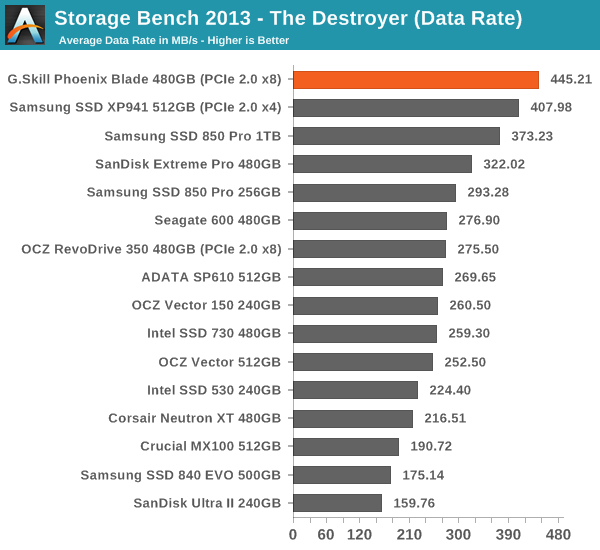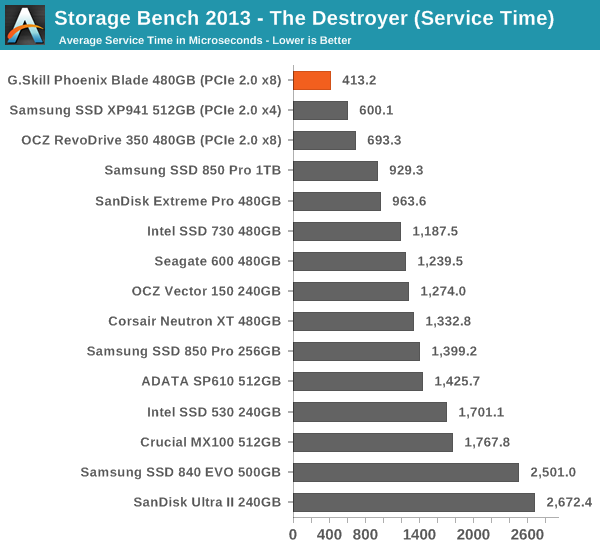G.Skill Phoenix Blade (480GB) PCIe SSD Review
by Kristian Vättö on December 12, 2014 9:02 AM ESTAnandTech Storage Bench 2013
Our Storage Bench 2013 focuses on worst-case multitasking and IO consistency. Similar to our earlier Storage Benches, the test is still application trace based – we record all IO requests made to a test system and play them back on the drive we are testing and run statistical analysis on the drive's responses. There are 49.8 million IO operations in total with 1583.0GB of reads and 875.6GB of writes. I'm not including the full description of the test for better readability, so make sure to read our Storage Bench 2013 introduction for the full details.
| AnandTech Storage Bench 2013 - The Destroyer | ||
| Workload | Description | Applications Used |
| Photo Sync/Editing | Import images, edit, export | Adobe Photoshop CS6, Adobe Lightroom 4, Dropbox |
| Gaming | Download/install games, play games | Steam, Deus Ex, Skyrim, Starcraft 2, BioShock Infinite |
| Virtualization | Run/manage VM, use general apps inside VM | VirtualBox |
| General Productivity | Browse the web, manage local email, copy files, encrypt/decrypt files, backup system, download content, virus/malware scan | Chrome, IE10, Outlook, Windows 8, AxCrypt, uTorrent, AdAware |
| Video Playback | Copy and watch movies | Windows 8 |
| Application Development | Compile projects, check out code, download code samples | Visual Studio 2012 |
We are reporting two primary metrics with the Destroyer: average data rate in MB/s and average service time in microseconds. The former gives you an idea of the throughput of the drive during the time that it was running the test workload. This can be a very good indication of overall performance. What average data rate doesn't do a good job of is taking into account response time of very bursty (read: high queue depth) IO. By reporting average service time we heavily weigh latency for queued IOs. You'll note that this is a metric we have been reporting in our enterprise benchmarks for a while now. With the client tests maturing, the time was right for a little convergence.

Quite surprisingly, the Phoenix Blade takes the lead in our 2013 Storage Bench and even beats the XP941. After reviewing the RevoDrive 350, I didn't get my hopes up for the Phoenix Blade, but it looks like G.Skill has done a much better job at optimizing the drive for performance.











62 Comments
View All Comments
Havor - Sunday, December 14, 2014 - link
What really sucks is that Intel continues attaching a PCH to the host processor through a four-lane DMI 2.0 connection on even the X99. You only get 2 GB/s of bi-directional throughput.So 3 disk R0 or 4 disk R5 is all it takes to saturate the DMI connection between chipset and CPU, even do you got 10x SATA3 connectors.
On the moment only solutions are M.2, PCIe to have a faster storage solution.
And for the desktop, only M.2 with native PCIe 3.x 4x will be able to to deliverer cost affectedly solutions, one's they finally have good SSD controllers developed.
alacard - Sunday, December 14, 2014 - link
You're preaching to the quire on that one. 2GB per second (actually only 1800MB/s after overhead) divided between 10 SATA ports, 14 USB (6 3.0) ports, Gigabit LAN, and 8 PCI express lanes, is an absolute joke.TheWrongChristian - Monday, December 15, 2014 - link
What you're missing is that while an SSD at peak speed can saturate a SATA 3 link, and 3 such drives can saturate 2GB/s DMI connection, even the best SSDs can rarely reach such speeds with normal workloads.Random (especially low queue depth 4K random) workloads tend to be limited to much lower speeds, and random IO is much more representative of typical workloads. Sequential workloads are usually bulk file copy operations, and how often do you do that?
So, given your 10x SATA 3 connectors, what workload do you possibly envisage that would require that combined bandwidth? And benchmark dick swinging doesn't count.
personne - Sunday, December 14, 2014 - link
My tasks are varied but they often involve opening large data sets and importing them into an inverted index store, at the same time running many process agents on the incoming data as well as visualizing it. This host is also used for virtualization. Programs loading faster is the least of my concerns.AllanMoore - Saturday, December 13, 2014 - link
Well you could see the blistering speed on 480Gb comparing to 240Gb version, see the table: http://picoolio.net/image/e4OEzioAs - Saturday, December 13, 2014 - link
I know RAID 0 (especially with 4 drives) theoretically would give high performance but is it really worth the data risks? I do question some laptop manufacturers or PC OEM to actually build a RAID 0 with SSDs for potential customers, it's just not a good practice imo.personne - Monday, December 15, 2014 - link
RAM is much more volatile than flash or spinning storage yet it has its place. SSDs are in a sense always RAID array since many chips are used. And it's been posted that the failure rate of a good SSD is much less than a HDD, multiple SSDs are still less than a single HDD. And one should always have good backups regardless. So if the speed is worth it it's not at at all unreasonable.Symbolik - Sunday, December 14, 2014 - link
I have 3x Kingston HyperX 240gb in Raid 0, I have 4 of them, but 3 maxes out my AMDraid gains, it is significant over 2 at around 1000 x 1100 r/w (ATTO diskbench). I have tried 4, the gain was minimal. To get further gains with the 4th, I'd probably need to put in an actual RAID card. I know it's not intel, but it is sandforce.Dug - Friday, December 12, 2014 - link
You say - "As a result the XP941 will remain as my recommentation for users that have compatible setups (PCIe M.2 and boot support for the XP941) because I'd say it's slightly better performance wise and at $200 less there is just no reason to choose the Phoenix Blade over the XP941, except for compatibility"I'm curious, what are you using to determine the XP941 has slightly better performance? It just seems to me most of the benchmarks favor the Phoenix Blade.
Kristian Vättö - Friday, December 12, 2014 - link
It's the 2011 Heavy Workload in particular where the XP941 performs considerably better than the Phoenix Blade, whereas in 2013 and 2011 Light suites the difference between the two is quite small. The XP941 also has better low QD random performance, which typically important for desktop workloads.